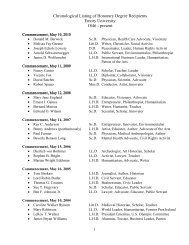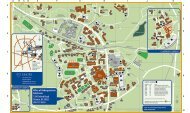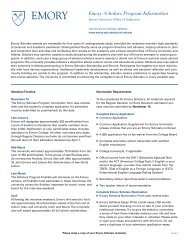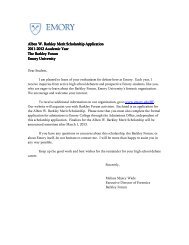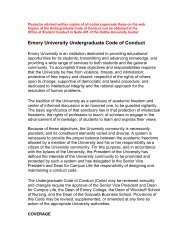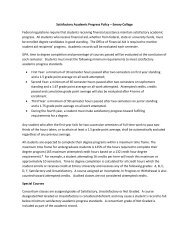DOSY Experiments - Emory University
DOSY Experiments - Emory University
DOSY Experiments - Emory University
You also want an ePaper? Increase the reach of your titles
YUMPU automatically turns print PDFs into web optimized ePapers that Google loves.
Step-by-step description<br />
To begin processing the gradient mapping data, first select the Process/NUG Calib panel.<br />
Figure 2 The Process/NUG Calib panel, used for processing gradient mapping data<br />
from the Doneshot_nugmap sequence<br />
To process the gradient map data, do the following:<br />
1. Click on Fourier Transform Profiles. This will perform a weighted Fourier transform of<br />
the FID data and display the first profile. A typical set of profiles (shown stacked<br />
vertically) obtained from the Doneshot_nugmap sequence is shown in Figure 3 below.<br />
2. Display the first spectrum and set integral regions manually.<br />
3. Now click the Baseline Correct All Profiles button. This will automatically baselinecorrect<br />
all the profiles using the integral settings defined above.<br />
4. From the Calibrant for gradient mapping drop-down menu, select either 'Pure H2O',<br />
'1%HOD' or 'Other', depending on which sample was used to obtain the profiles. If 'Other'<br />
was selected, enter the expected diffusion coefficient for the calibrate at the temperature<br />
the data were recorded at.<br />
5. Enter the (calibrated) temperature that the data were recorded at into the relevant field.<br />
6. Check or uncheck the options 'Copy NUG coeffs to global parameters' and<br />
'Store/update NUG coeffs in probe file' as appropriate. If this is the first time the<br />
calibration has been done for a particular probe, it is recommended that these options be<br />
checked.<br />
7. Click 'Calculate NUG coefficients'. a semi-logarithmic plot of the calculated versus fitted<br />
signal attenuation will be displayed, together with the calculated NUG coefficient.<br />
The Calculated nugcal_ array contains the NUG coefficients calculated using the original<br />
(uncorrected) probe file value of gcal (stored locally as gcal_). The Corrected nugcal_ array<br />
contains the NUG coefficients calculated instead using a corrected version of gcal_<br />
Corrected gcal_ = Original gcal_ * Correction factor<br />
where the Correction factor is the square root of the second NUG coefficient. The corrected<br />
gcal is stored in the probe file as parameter Probegcal_corrd (see Section 3.4). Note that any<br />
<strong>DOSY</strong> measurements recorded after the gradient mapping has been carried out will use the<br />
corrected value of gcal in place of the original gcal. The corrected value is the signal-weighted<br />
average of the gradient strengths across the sample, and is generally different from that obtained<br />
from the width of the signal profile; the latter method is relatively inaccurate and does not allow for<br />
gradient non-uniformity corrections.<br />
16






